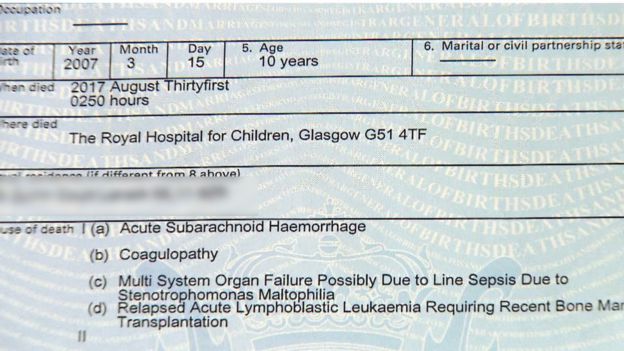
Above, the uniquely Scottish media politicising of a mother’s grief. Below, the death certificate containing the evidence regarding the possible, contributory infection:

‘Stenotrophomonas maltophilia is an aerobic, nonfermentative, Gram-negative bacterium. It is an uncommon bacterium and human infection is difficult to treat. S. maltophilia is ubiquitously present in the environment and impossible to eradicate, which makes prevention also extremely difficult.’
https://en.wikipedia.org/wiki/Stenotrophomonas_maltophilia
As for the repeated suggestions that the hospital water supply system was the source of the infection, it seems that this bacterium can pass through filter units: https://www.ncbi.nlm.nih.gov/pmc/articles/PMC3255966/
Again, I stress, I’m not a medic, so I welcome clarification and/or correction from readers better qualified but does this not suggest that criticism of the QEUH for a failure to prevent the presence of the above bacterium in its children’s cancer wards is unwarranted as it cannot be eradicated and is everywhere at all times in our surroundings?
Do the parents know this? Did the politicians, Anas Sarwar, and the reporters, BBC Scotland, know this and fail to tell them? Am I missing something?

Even if Anas Sanwar knew this he would sideline it , as would the Scottish media , their goal is not to tell the truth the whole truth and nothing but the truth , their goal is to tell half truths and half stories to exploit vulnerable people , anything will do to make a story SNP baad ! .
LikeLiked by 1 person
Not sure it cannot be filtered out of water at point of dispense but if it is ubiquitous it is in the air, potentially everywhere. Short of a completely sterile and positive pressure isolation unit?
Has it been found in water supply?
The child might have been weak or with a compromised immunity system, but that is why we have as a last line of defence, antibiotics.
LikeLiked by 1 person
Perhaps this summary will help:
“”This summary from GARD:
“”Stenotrophomonas maltophilia (S. maltophilia) infection is a type of bacterial infection. S. maltophilia is found mostly in wet environments. In the hospital setting, S. maltophilia can be found in fluids, such as irrigation solutions (fluids used to clean a wound or wash out a body cavity like the ear canal or bladder) and intravenous (IV) fluids, as well as patient secretions, such as mucus from the respiratory tract and urine. The bacteria causes problems mainly in people who have a weakened immune system.[1][2][3] To cause infections in healthy people, S maltophilia must bypass the normal human defenses, as can happen with the use of certain medical devices, such as catheters or IV lines. People who are hospitalized and receiving treatment for other serious medical conditions may be more susceptible to an infection, especially if their immune system is weakened. Symptoms vary depending on the area of the body infected.[1][2]
Diagnosis of S. maltophilia infection, along with other bacterial infections, may be suspected by symptoms and risk factors. A culture of body fluids, such a blood, urine, sputum, or abdominal fluid, is used to confirm the specific type of bacteria. A consultation with an infectious disease specialist is important to differentiate bacterial colonization (where the bacteria are found in the body but do not cause symptoms) from an infection and to determine the best treatment options. [1][2] “”
https://rarediseases.info.nih.gov/diseases/9772/stenotrophomonas-maltophilia-infection
The child was being treated for leukaemia so basically her immune system was non-existent. Increasingly bacterial resistance is rendering a wide range of antibiotics ineffective.
As far as I am aware there has not been any definitive statement as to whether it was present in the water supply. It has been said that no source for the bacteria had been identified
LikeLiked by 1 person
Thanks for that Legerwood.
It is years since since I did my bacteriology and I never came across that particular organism.
Leukaemia would have reduced the child’s natural defences but why is the TV going with the certainty it was by way of contaminated water and I would guess there would have been a high level of prevention set up to prevent such a thing?
Stinks, sadly of a new version of ambulance chasing.
LikeLiked by 1 person
Bugger the Panda
If I remember correctly this particular bacterium was identified in the 1940s and it is only in the last 10 years or so that it has emerged as a problem in hospitals particularly in facilities dealing with immuno-compromised patients. Although it is present in the general population it does not seem to cause problems.
LikeLiked by 2 people
Bugger (the Panda)
As the bacterium was found in the water around the same time a tentative and dishonest link has been made
LikeLiked by 2 people